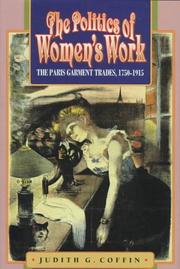| Listing 1 - 7 of 7 |
Sort by
|

ISBN: 0691034478 1306984297 9781400864324 1400864321 9781306984294 Year: 1996 Publisher: Princeton Princeton University Press
Abstract | Keywords | Export | Availability | Bookmark
 Loading...
Loading...Choose an application
- Reference Manager
- EndNote
- RefWorks (Direct export to RefWorks)
Few issues attracted more attention in the nineteenth century than the "problem" of women's work, and few industries posed that problem more urgently than the booming garment industry in Paris. The seamstress represented the quintessential "working girl," and the sewing machine the icon of "modern" femininity. The intense speculation and worry that swirled around both helped define many issues of gender and labor that concern us today. Here Judith Coffin presents a fascinating history of the Parisian garment industry, from the unraveling of the guilds in the late 1700s to the first minimum-wage bill in 1915. She explores how issues related to working women took shape and how gender became fundamental to the modern social division of labor and our understanding of it.
Clothing trade --- Needlework industry and trade --- Women clothing workers --- Women --- Human females --- Wimmin --- Woman --- Womon --- Womyn --- Females --- Human beings --- Femininity --- Clothing workers --- Women textile workers --- Textile industry --- Apparel industry --- Clothiers --- Clothing industry --- Garment industry --- Rag trade --- Tailors --- History --- Employment&delete& --- Fashion industry --- Labour market --- Manufacturing technologies --- History of France --- anno 1800-1999 --- History. --- Employment --- France --- Paris (France) --- Women clothing workers - France - Paris - History. --- Women - Employment - France - Paris - History. --- Clothing trade - France - Paris - History. --- Needlework industry and trade - France - Paris - History. --- Vêtements --- Travaux à l'aiguille --- Femmes --- Vêtement, Travailleuses du --- Industrie et commerce --- Histoire --- Industrie --- Travail --- Business & Economics --- Labor & Workers' Economics --- FEMMES --- TRAVAIL ET TRAVAILLEURS --- VETEMENTS --- PARIS (FRANCE) --- TRAVAIL --- 18E-20E SIECLES --- FRANCE --- CONDITIONS SOCIALES --- INDUSTRIE ET COMMERCE --- CONDITIONS ECONOMIQUES --- 19E-20E SIECLES
Book
ISBN: 1501750550 1501750569 1501750542 9781501750557 9781501750564 9781501750540 Year: 2020 Publisher: Ithaca
Abstract | Keywords | Export | Availability | Bookmark
 Loading...
Loading...Choose an application
- Reference Manager
- EndNote
- RefWorks (Direct export to RefWorks)
When this work's author discovered a virtually unexplored treasure trove of letters to Simone de Beauvoir from Beauvoir's international readers, it inspired the author to explore the intimate bond between the famed author and her reading public. This correspondence, at the heart of the book, immerses us in the tumultuous decades from the late 1940s to the 1970s - from the painful aftermath of World War II to the horror and shame of French colonial brutality in Algeria and through the dilemmas and exhilarations of the early gay liberation and feminist movements. The letters provide a glimpse into the power of reading and the power of readers to seduce their favorite authors.
Authors, French --- Authors and readers --- Readers and authors --- Authorship --- Correspondence. --- History --- Beauvoir, Simone de, --- de Beauvoir, Simone, --- de Beauvoir, Simone --- Beauvoir, Simone de --- Beauvoir, S. de --- De Beauvoir, Simone --- Bofuwa, Ximengna de --- Bōvōwāru, Shimōnu do --- Bovuar, Simona de --- Būfwār, Sīmūn Dū --- De Bofuwa, Ximengna --- Po-wa, Hsi-meng --- Castor --- Beauvoir, Postwar, Algerian war, feminism, political emotion, epistolarity, existentialism, philosophy.
Book
Year: 1996 Publisher: Princeton University Press
Abstract | Keywords | Export | Availability | Bookmark
 Loading...
Loading...Choose an application
- Reference Manager
- EndNote
- RefWorks (Direct export to RefWorks)
Women clothing workers --- Women --- Clothing trade --- Needlework industry and trade --- History. --- Employment
Article
Abstract | Keywords | Export | Availability | Bookmark
 Loading...
Loading...Choose an application
- Reference Manager
- EndNote
- RefWorks (Direct export to RefWorks)
Article
Abstract | Keywords | Export | Availability | Bookmark
 Loading...
Loading...Choose an application
- Reference Manager
- EndNote
- RefWorks (Direct export to RefWorks)
Book
ISBN: 9782259315395 2259315399 Year: 2023 Publisher: Paris: Plon,
Abstract | Keywords | Export | Availability | Bookmark
 Loading...
Loading...Choose an application
- Reference Manager
- EndNote
- RefWorks (Direct export to RefWorks)
Entre la parution du Deuxième Sexe en 1949 et la fin de sa vie en 1986, Simone de Beauvoir aura reçu plus de 20 000 lettres. Des lectrices et des lecteurs de tous horizons écrivent à la " géniale et courageuse femme de lettres " pour la consulter sur l'amour, le mariage, la contraception. Des quatre coins du monde, on confie à " Madame de Beauvoir " ses engagements politiques, son homosexualité hésitante ou encore l'horreur des avortements clandestins, mais aussi la honte de la colonisation algérienne et les douloureuses séquelles laissées par deux guerres mondiales.De cette correspondance extraordinaire, véritable miroir de la condition existentielle des femmes et des hommes de l'époque, Beauvoir elle-même avait envisagé de faire un livre. Sexe, amour et féminisme est le premier à en explorer les archives.Judith Coffin nous entraîne dans le tumulte de décennies révolutionnaires où l'on croise aussi les militantes du MLF, Gisèle Halimi, Frantz Fanon et Betty Friedan. Son livre est une illustration saisissante du pouvoir de la lecture : il nous révèle le lien intime complexe et souvent contrarié que l'écrivaine avait tissé avec son public. La connaissance que nous avons de Simone de Beauvoir et de son œuvre en ressort transformée.
Authors, French --- Authors and readers --- Beauvoir, Simone de, - 1908-1986


ISBN: 9781501724183 1501724185 0801429226 9780801429224 0801481465 9780801481468 Year: 2018 Publisher: Ithaca, NY
Abstract | Keywords | Export | Availability | Bookmark
 Loading...
Loading...Choose an application
- Reference Manager
- EndNote
- RefWorks (Direct export to RefWorks)
| Listing 1 - 7 of 7 |
Sort by
|

 Search
Search Feedback
Feedback About UniCat
About UniCat  Help
Help News
News